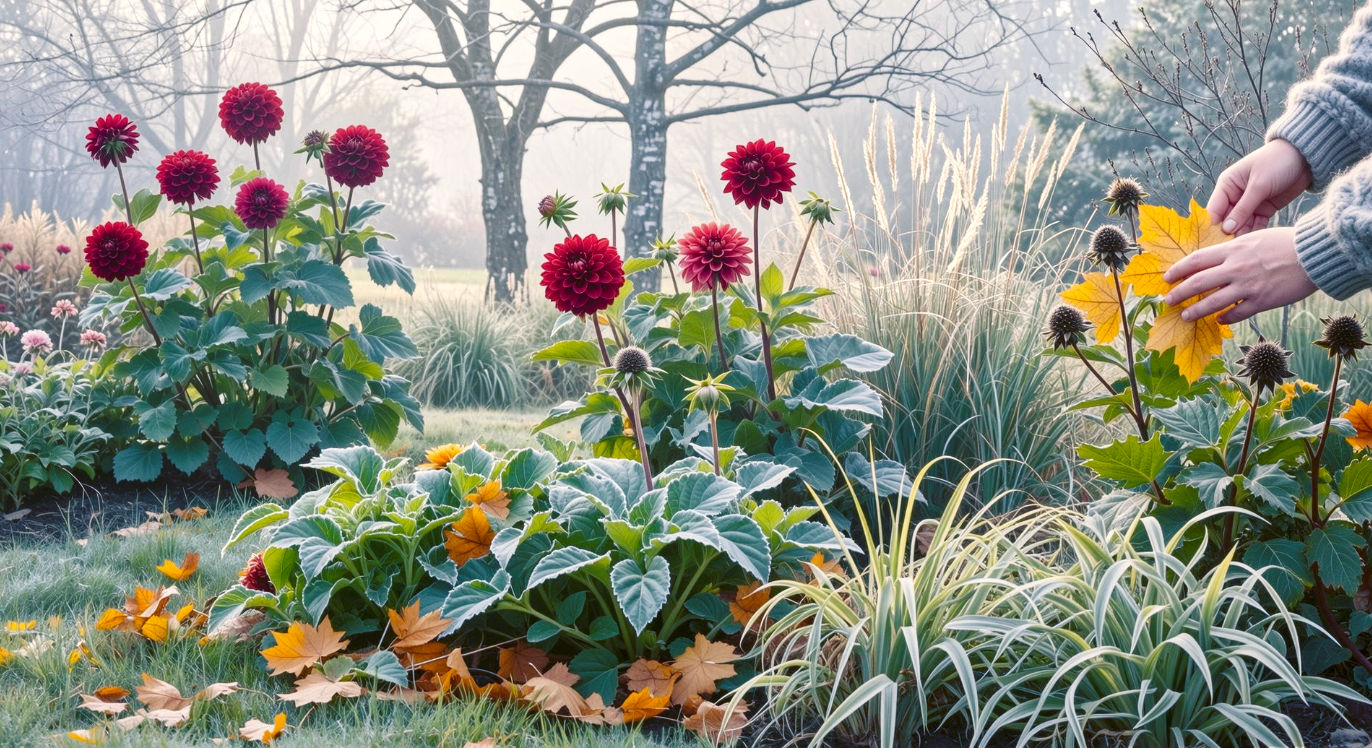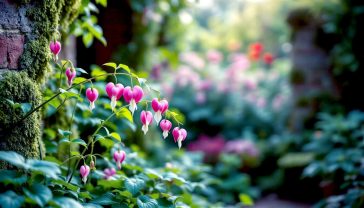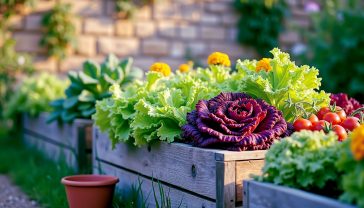The Great British Garden Shift: How to Master the Art of Transitional Tending
Stop fighting the seasons and start working with them. Our definitive guide shows you how to manage your garden through the year for stunning results.

This post may contain affiliate links. If you make a purchase through these links, we may earn a commission at no additional cost to you.
Ever get that feeling? The first crisp morning in September when you know, you just know, autumn’s knocking. Or that sudden, glorious burst of sunshine in March that sends you rushing outside, blinking in the light? That’s your garden calling. It’s telling you that things are about to change.
Gardening in Britain isn’t just about planting in spring and hoping for the best. Oh no. It’s a year-long conversation, a constant dance with the seasons. It’s about knowing when to tidy up and when to let things be, when to plant and when to prune. This is transitional tending: the quiet, clever art of shifting your garden’s focus as one season melts into the next. It’s about creating a space that doesn’t just survive the year but looks stunning right through it.
Forget the frantic spring rush or the mad autumn clear-up. We’re going to look at your garden as a living, breathing thing that changes month by month. We’ll cover everything from waking it up after a long, damp winter to tucking it in for a frosty night. Whether you’ve got a sprawling country patch, a tidy suburban lawn, or a few pots on a city balcony, this guide is your new best friend. Let’s get our hands dirty and learn how to work with the seasons, not against them.
What on Earth is Transitional Tending?
Right then, let’s get this sorted. Transitional tending is simply the practice of managing your garden during the in-between moments—the crossover weeks when winter is still grumbling but spring is definitely in the air, or when the high summer sun starts to dip a little lower, hinting at autumn.
Think of it like changing your wardrobe. You don’t jump from a thick winter coat straight into shorts and a t-shirt, do you? Of course not. You have your lighter jackets, your gilets, your cardigans for those awkward ‘is it warm, is it cold?’ days. Transitional tending is the gardening version of that. It’s about making small, smart adjustments that help your garden move smoothly from one season to the next.
This isn’t about following a rigid set of rules. Your garden in the Scottish Highlands will have a very different calendar to one basking on the Cornish coast. Instead, it’s about learning to read the signs. Look at the buds on the trees. Feel the change in the air. Notice which birds are visiting your feeder. These are the clues that tell you it’s time to start shifting your focus.
Why does it matter?
- A Better-Looking Garden: By managing the transitions, you avoid that ugly, messy phase where summer plants have died back but winter ones haven’t kicked in yet. You get a garden that has interest all year round.
- Healthier Plants: You’re giving your plants what they need, when they need it. This means stronger roots, better flowers, and fewer problems with pests and diseases.
- Happier Wildlife: A garden that offers food and shelter throughout the year is a haven for birds, bees, hedgehogs, and all sorts of other welcome visitors.
- Less Work for You: Honestly! A little bit of work often saves a massive job later on. Dealing with weeds before they set seed or tidying up dying plants before they turn to mush makes life so much easier.
It’s a gentler, more thoughtful way of gardening. It’s about being a partner to your garden, not just its boss.
The Late Winter to Early Spring Transition: The Great Awakening
This is perhaps the most exciting transition of all. After months of grey skies and soggy lawns, the world starts to wake up. The days get a little longer, the birds start singing a bit louder, and you can almost smell the change in the air. But don’t be fooled—a sharp frost or even a flurry of snow could still be lurking. This transition is all about preparation and patience.
Reading the Signs
- The First Flowers: Snowdrops, crocuses, and winter aconites start pushing through the cold soil. These are the true pioneers of the gardening year.
- Buds Swelling: Look closely at the branches of trees and shrubs like magnolias, forsythias, and fruit trees. You’ll see the buds getting fatter, ready to burst.
- Weed Alert: Annoying, I know, but the first weeds are a sure sign the soil is warming up. You’ll spot bittercress, chickweed, and groundsel making a break for it.
- Wildlife Activity: Birds are pairing up and starting to scout for nesting sites. You might even see a queen bumblebee buzzing drowsily on a sunny day.
Your Transitional To-Do List
The Grand Tidy-Up (But a Gentle One)
Your main job is to clear away the debris of winter so that new growth has room to shine.
- Cut Back Old Growth: Snip off the dead, brown stems of last year’s perennials (like sedums, asters, and grasses). You left them over winter to provide shelter for insects, but now it’s time for them to go. Chop them up and add them to the compost heap.
- Rake the Lawn: Gently rake your lawn to remove any fallen leaves, twigs, and moss. This lets air and light get to the grass, encouraging it to grow. Don’t go mad with a heavy rake, as the ground is still soft.
- Edge Your Beds: Use a half-moon edger or a sharp spade to recut the edges of your borders. It’s like giving your garden a sharp new haircut—it instantly makes everything look smarter.
Pruning Power
Late winter is the perfect time for a bit of strategic snipping. The plants are dormant (asleep), so it’s less of a shock for them.
- Summer-Flowering Shrubs: This is the moment for things like Buddleja (butterfly bush), Lavatera, and late-flowering Clematis (Group 3). They flower on new wood, so cutting them back hard now encourages lots of fresh, flower-bearing stems.
- Roses: Bush roses, like Hybrid Teas and Floribundas, need a good prune now to encourage a classic, open shape and plenty of blooms. Cut back to an outward-facing bud, about 15-30cm from the base.
- Wisteria: Give your wisteria its second prune of the year (the first was in summer). Cut back the side shoots you trimmed in August to just two or three buds. This is what encourages those glorious waterfalls of flowers.
- Fruit Trees: It’s the last call for pruning apple and pear trees. You’re aiming for an open, goblet shape to let light and air into the centre of the tree.
Crucial Tip: Don’t prune spring-flowering shrubs like Forsythia or Ribes (flowering currant) now! If you do, you’ll cut off all the flower buds for this year. Wait until they’ve finished flowering, then prune them.
Feeding the Soil
Your soil has been working hard all last year. Now’s the time to give it a thank-you meal.
- Mulch, Mulch, Mulch: Spread a thick layer (at least 5cm) of well-rotted manure, garden compost, or mushroom compost over your borders. This is the single best thing you can do for your garden. It feeds the soil, locks in moisture, and keeps weeds down. There’s no need to dig it in; the worms will do that for you. Just spread it over the surface, being careful not to bury any emerging shoots.
- Feed Your Pots: Plants in containers have used up all their nutrients. Scrape off the top 5cm of old compost and replace it with fresh, peat-free compost mixed with some slow-release fertiliser granules.
Planning and Planting
- Plant Bare-Root: This is your last chance to plant bare-root trees, shrubs, and roses. They are much cheaper than pot-grown ones and establish really well when planted now.
- Sow Hardy Seeds: If the soil isn’t frozen or waterlogged, you can start sowing hardy annuals like Nigella (love-in-a-mist) and Calendula (pot marigolds) directly where you want them to flower. You can also start sowing vegetables like broad beans, parsnips, and early peas.
- Chit Your Potatoes: ‘Chitting’ just means encouraging your seed potatoes to sprout before you plant them. Stand them on end in an egg box on a cool, bright windowsill. The little purple or green shoots that appear will give them a head start.
The Spring to Summer Transition: Full Steam Ahead
This is the busiest, most exciting time in the garden. Everything is growing at a furious pace. The transition from the fresh, hopeful days of spring to the lush abundance of summer is all about managing that explosive growth. You need to provide support, keep on top of weeds, and make sure everything has enough food and water to perform at its peak.
Reading the Signs
- The ‘Chelsea Chop’ Time: When perennials like Sedum and Phlox are about 30-40cm tall, it’s a sign that growth is well underway. This is around the time of the RHS Chelsea Flower Show in late May, hence the name.
- First Roses Appear: The first flush of rose blooms signals the start of summer proper.
- Swifts Arrive: Hearing the screaming calls of swifts overhead is a classic sign that summer is here to stay. They usually arrive in the UK in early May.
- Warmer Soil: The soil is no longer cold to the touch. It’s warm and crumbly, perfect for planting out tender plants.
Your Transitional To-Do List
Support and Control
- Stake Your Perennials: Taller plants like delphiniums, lupins, and peonies will flop over and snap in the first summer rain or wind if you don’t support them. Put stakes or plant supports in now, while the plants are still small. They will quickly grow up through the supports, hiding them from view. It’s much harder to wrestle a giant, collapsed plant back into a support later!
- The Chelsea Chop: This sounds brutal, but it’s a brilliant technique. For late-flowering perennials, you can cut the front third of the clump back by about half. This will make the front of the plant flower a bit later and at a lower height, giving you a longer, more tiered display. It also stops them from getting too leggy.
- Tie in Climbers: Keep tying in the new shoots of climbing roses, clematis, and honeysuckle to their supports. Guide them where you want them to go to ensure good coverage and lots of flowers.
- Weed Relentlessly: This is your moment to win the war on weeds. Hoe your borders on a dry, sunny day. The tiny weed seedlings will be sliced off and shrivel on the surface. A few minutes of hoeing every week now will save hours of hand-weeding later.
Planting Out and Sowing
- The Great Plant-Out: Once all risk of frost has passed (usually late May, but check your local forecast), you can plant out the tender plants you’ve been growing indoors. This includes summer bedding like petunias and geraniums, and tender vegetables like tomatoes, courgettes, and runner beans.
- Harden Off First: Don’t just chuck them outside! You need to ‘harden them off’ – get them used to the outdoor conditions gradually. For a week or two, put them outside during the day and bring them back in at night.
- Successional Sowing: Keep sowing fast-growing crops like lettuce, radish, and beetroot every couple of weeks. This ensures you have a continuous harvest all summer, rather than a massive glut all at once.
- Direct Sow: Now the soil is warm, you can sow tender annuals like nasturtiums and cosmos directly into the ground.
Watering and Feeding
- Water Wisely: It’s much better to give your plants a really deep soaking once or twice a week than a little sprinkle every day. This encourages their roots to go deep down in search of water, making them more resilient. Water the soil, not the leaves, to reduce the risk of fungal diseases.
- Feed the Hungry: Anything that produces lots of flowers or fruit is a ‘gross feeder’ – a greedy plant! This includes roses, sweet peas, tomatoes, and everything in your hanging baskets. Start feeding them with a high-potash liquid fertiliser (like a tomato feed) every week or two once they start flowering.
The High Summer to Early Autumn Transition: The Golden Hours
Summer in the garden is glorious, but it can also be exhausting—for you and your plants! The transition into autumn is a time to take a breath, enjoy the fruits of your labour, and gently start preparing for the cooler months ahead. It’s about keeping things looking good, harvesting, and planning for next year’s display.
Reading the Signs
- The Light Changes: The sun is lower in the sky, casting long shadows in the late afternoon. The light takes on a beautiful, golden quality.
- First Leaves Turn: You’ll spot the first yellow or red leaves on trees like Acers and Virginia creepers.
- Heavy Dew: Mornings are often misty, with everything draped in a heavy dew that sparkles in the sun.
- Spiders Everywhere: Suddenly, you’ll notice cobwebs covering every shrub and fence. Orb-weaver spiders are at their busiest now.
Your Transitional To-Do List
Maintaining the Show
- Deadhead, Deadhead, Deadhead: This is your number one job. As soon as a flower starts to fade, snip it off. This stops the plant from putting its energy into making seeds and encourages it to produce more flowers instead. It works for almost everything, from roses and dahlias to cosmos and petunias.
- Cut Back and Revive: Some early summer perennials, like hardy geraniums and Alchemilla mollis (lady’s mantle), can start to look a bit tired and messy. Don’t be afraid to chop the whole lot back to the ground. Give them a good water and a feed, and they will often produce a fresh flush of leaves and even a second, smaller flush of flowers.
- Keep Watering: An ‘Indian summer’ in September can be very dry. Keep watering your pots and any newly planted things. Camellias and rhododendrons are forming their flower buds for next spring now, and they’ll drop them if they get too dry.
Harvesting and Collecting
- Gather Your Crops: Keep picking your vegetables. Runner beans, courgettes, and tomatoes will keep producing as long as you keep picking them. Harvest apples and pears as they ripen.
- Collect Seeds: This is a lovely, money-saving job for a dry afternoon. Collect seeds from your favourite annuals (like Nigella and poppies) and perennials (like aquilegias and lupins). Put them in paper envelopes, label them clearly, and store them somewhere cool and dry.
- Take Cuttings: Early autumn is a great time to take semi-ripe cuttings from shrubs like lavender, fuchsia, and rosemary. These are cuttings taken from this season’s growth that is hard at the base but still soft at the tip. They root really easily and give you free plants for next year.
Planning for Spring
- Order Your Bulbs: Don’t wait until the sad-looking bags are left in the garden centre! Order your spring-flowering bulbs now for the best choice. Think about daffodils, tulips, crocuses, and alliums.
- Prepare for Planting: As summer bedding starts to fade, pull it out and get the ground ready for autumn planting. Clear away weeds and dig in some fresh compost.
- Lawn Care: Autumn is the best time to give your lawn some TLC. It’s had a hard summer of being walked on, played on, and possibly scorched. Rake it vigorously (scarify) to remove moss and thatch, then spike it with a garden fork (aerate) to improve drainage. Finally, give it an autumn lawn feed, which is high in potassium to encourage strong roots for the winter.
The Autumn to Winter Transition: Time to Tuck In
This final transition is a slow, graceful winding down. The colours are magnificent, the air is crisp, and the garden is preparing for its long winter sleep. Your job is to help it along, protecting vulnerable plants and ensuring everything is safe and tidy for the months ahead. But this isn’t about stripping the garden bare; it’s about leaving some structure and shelter for wildlife.
Reading the Signs
- The Last Mowing: The grass stops growing, and you put the mower away for the last time.
- Leaves Falling: The main leaf-fall from deciduous trees signals that winter is truly on its way.
- First Frosts: You’ll wake up to a garden sparkling with the first hard frost of the season.
- Winter Birds Arrive: Look out for visitors like redwings and fieldfares, who fly to the UK from Scandinavia for the winter.
Your Transitional To-Do List
Protection and Prevention
- Bring in the Tender: Before the first frosts, you must bring any tender plants indoors. This includes things like pelargoniums (geraniums), fuchsias, and citrus trees in pots. Store them in a frost-free place like a greenhouse, conservatory, or even a cool porch.
- Protect the Vulnerable: For plants that are too big to move or are borderline hardy (like some agapanthus or tree ferns), you need to protect them in place. Wrap the pots in bubble wrap or hessian to stop the roots from freezing. You can wrap the plant itself in horticultural fleece.
- Lift Your Tubers: Dahlia and begonia tubers won’t survive a cold, wet British winter in the ground (unless you live in a very mild area). Carefully dig them up after the first frost has blackened their leaves. Clean off the soil, let them dry, and store them in a box of dry sand or compost in a frost-free shed.
- Prevent Wind Rock: Newly planted shrubs and tall roses can get rocked about by winter winds, which creates a hole around the stem where water can collect and freeze. Firm the soil around them and consider cutting them back by a third to reduce their height.
The Final Tidy
- Collect Fallen Leaves: Don’t let fallen leaves sit on your lawn, as they will kill the grass. Rake them up. But don’t throw them away! They are garden gold. Pack them, damp, into a bin bag, poke some holes in it, and leave it somewhere out of the way for a year or two. This will rot down into fantastic, free leaf mould, which is a brilliant soil conditioner.
- Clean Your Tools: Before you put them away, give your spade, fork, and hand tools a good clean. Scrape off any mud, wipe them with an oily rag to prevent rust, and get your mower and secateurs serviced and sharpened, ready for spring.
- A Note on Leaving Shelter: It’s tempting to cut everything back and make the garden look perfectly tidy. Please don’t! The hollow stems of dead perennials and the seed heads of plants like teasels and grasses provide vital food and shelter for insects and birds over winter. Leave some interesting dead stuff standing. It looks beautiful too, especially when rimed with frost.
Winter Planting
- Plant Your Tulips: November is the best time to plant tulip bulbs. Planting them this late helps to avoid a disease called tulip fire. Plant them deep—at least twice the depth of the bulb.
- Garlic and Onions: You can plant garlic cloves and autumn-planting onion sets now for an extra-early crop next year. They need a cold spell to get them going.
- Plant Bare-Root Trees and Hedges: As soon as the leaves have fallen, the planting season for bare-root deciduous trees and hedging begins again.
Your Garden is a Story, Not a Task List
And there you have it. The year in your garden isn’t four separate acts; it’s a flowing, continuous story. By paying attention to the small shifts and changes, you can become a better, more intuitive gardener.
Transitional tending isn’t about adding more jobs to your list. It’s about doing the right job at the right time. It’s about mulching in late winter to save yourself from watering in summer. It’s about staking in spring to save your delphiniums from a summer storm. It’s about collecting seeds in autumn to give you free flowers next spring.
So next time you step outside, take a moment. Look, listen, and feel. What is your garden telling you? Is it yawning and stretching after a long winter, or is it getting ready to pull the duvet up for a well-earned rest? Learn to read its language, and you’ll be rewarded with a garden that is healthier, more beautiful, and a true joy to be in, whatever the season.
Further Reading
- Royal Horticultural Society (RHS): The ultimate authority on all things gardening in the UK. Their website is a treasure trove of advice. https://www.rhs.org.uk/
- BBC Gardeners’ World: Practical, friendly advice from the team behind the beloved TV show. https://www.gardenersworld.com/
- The National Trust: Full of inspiration for grand gardens and practical tips for your own patch. https://www.nationaltrust.org.uk/gardens-and-parks
- The Wildlife Trusts: The go-to resource for making your garden a haven for wildlife. https://www.wildlifetrusts.org/gardening






